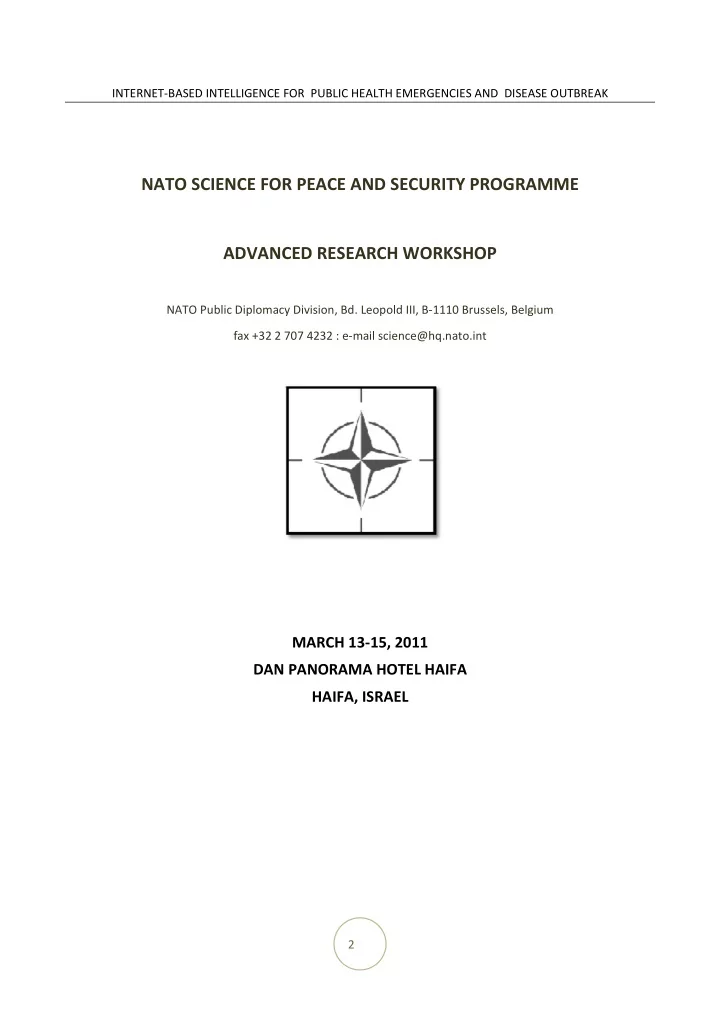

INTERNET ‐ BASED INTELLIGENCE FOR PUBLIC HEALTH EMERGENCIES AND DISEASE OUTBREAK NATO SCIENCE FOR PEACE AND SECURITY PROGRAMME ADVANCED RESEARCH WORKSHOP NATO Public Diplomacy Division, Bd. Leopold III, B ‐ 1110 Brussels, Belgium fax +32 2 707 4232 : e ‐ mail science@hq.nato.int MARCH 13 ‐ 15, 2011 DAN PANORAMA HOTEL HAIFA HAIFA, ISRAEL 2
INTERNET ‐ BASED INTELLIGENCE FOR PUBLIC HEALTH EMERGENCIES AND DISEASE OUTBREAK O RGANIZING C OMMITTEE Co ‐ Directors Emilio Mordini Manfred Green Centre for Science, Society and Citizenship, Rome, School of Public Health at Haifa University, Haifa, Italy Israel Committee Members François M.H. Géré Toby Merlin Institut Français d'Analyse Stratégique, Paris, France Influenza Coordination Unit Centers for Disease Control and Prevention, Atlanta, USA Secreteriat: Centre for Science, Society and Citizenship Piazza Capo di Ferro 23, 00186 Rome, Italy Phone: +39 0645551042/3 ‐ Fax: +39 0645551044 Email: cssc@cssc.eu 3
INTERNET ‐ BASED INTELLIGENCE FOR PUBLIC HEALTH EMERGENCIES AND DISEASE OUTBREAK Need A number of initiatives aimed at identifying health crises earlier than existing official monitoring systems are in progress. Web crawlers – automated software programs that scour the web for information – are increasingly used to find patterns that may signify an emerging threat. “ Over the past 15 years, Internet technology has become integral to public health surveillance. Systems using informal electronic information have been credited with reducing the time to recognition of an outbreak, preventing governments from suppressing outbreak information, and facilitating public health responses to outbreaks and emerging diseases ” 1 . Yet Internet ‐ based systems for outbreak detection still lack a calm and reflective evaluation, which includes not only an assessment of their technical reliability but also a careful analysis of their policy and regulatory implications. The main issues include; 1) Whether web ‐ crawler systems are truly able to extract reliable data on emerging crises from the Internet; 2) How it is possible to deal with information overload, false reports, lack of specificity of signals; 3) How it is possible to exploit new mobile technologies to engage directly with citizens to report illness; 4) How it is possible to minimize the risk that affected groups might deliberately provoke false alarms; 5) Whether it is possible to also apply this technology to the early detection of other kinds of crisis (e.g., conflicts, environmental disasters, financial crisis, etc). 6) How it is possible to improve the coverage of developing countries, where news sources are fewer; 7) Political impact given that Internet based systems bypass state based epidemiological surveillance. 8) How it is possible to implement public verification and follow ‐ up procedures; 9) Privacy concerns for strategies that have the potential to identify individual internet activity. Importance The potential threat of infectious diseases to the security of human life and global stability is very real. In a closely interconnected and interdependent world, new infectious diseases may adversely affect economic growth, trade, tourism, business and industry, and social stability as well as public health 2 . Severe high ‐ mortality rate pandemics due to highly ‐ transmissible viruses are a real threat for the world in the 21st century. Over the past three decades, scientists have identified more than 30 "new" infectious diseases, including HIV/AIDS, SARS, Ebola, and the West Nile Virus. In addition, the risk of infectious diseases crossing species boundaries may be more frequent, as in the case of “mad cow disease” and the threat of “swine flu.” Public health measures to control and fight emerging infectious diseases are still limited 3 . Governments have to weigh the benefits and harms of exposing people, communities and whole countries to possible discrimination and economic insult through epidemic controls. A range of negative outcomes are possible including a population's refusal to accept preventive measures or treatment regimens such as isolation and quarantine. Inappropriate public health responses may cause social disruption and civil disobedience. Beyond the immediate human health toll of epidemic crises, there may be damage inflicted by stereotyping, stigmatization and staggering economic losses. Another aspect of epidemics in our age is that it is hard to distinguish a natural disease outbreak from an intentionally caused biological threat. The combined danger arising from the bioterrorist threats to public order and the emergence of naturally ‐ occurring new infections demand novel solutions and particular attention. 1 Brownstein JS, Freifeld CC, Madoff LC. (2009) Digital disease detection ‐‐ harnessing the Web for public health surveillance. N Engl J Med . 21;360(21):2153 ‐ 5, 2157 2 Klaucke D. (2002) Globalization and Health: A Framework for Analysis and Action . Presentation at the Institute of Medicine Workshop on the Impact of Globalization on Infectious Disease Emergence and Control: Exploring the consequences and the Opportunities, Washington, D.C. Institute of Medicine Forum on Emerging Infections. 3 Smolinski, M, Hamburg, MA, Lederberg, J (2001) Microbial Threats to Health; Emergence, Detection, and Response . Institute of Medicine of the National Academies: Washington DC. 4
Recommend
More recommend